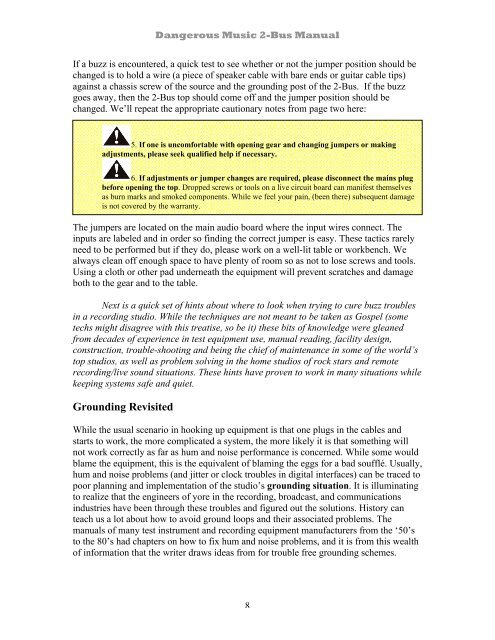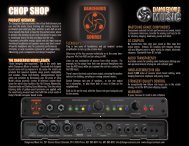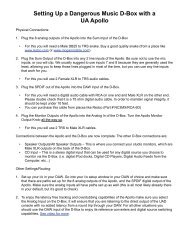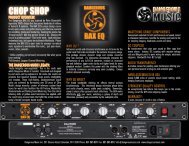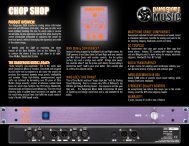The Dangerous Music 2-Bus Manual
The Dangerous Music 2-Bus Manual
The Dangerous Music 2-Bus Manual
You also want an ePaper? Increase the reach of your titles
YUMPU automatically turns print PDFs into web optimized ePapers that Google loves.
<strong>Dangerous</strong> <strong>Music</strong> 2-<strong>Bus</strong> <strong>Manual</strong><br />
If a buzz is encountered, a quick test to see whether or not the jumper position should be<br />
changed is to hold a wire (a piece of speaker cable with bare ends or guitar cable tips)<br />
against a chassis screw of the source and the grounding post of the 2-<strong>Bus</strong>. If the buzz<br />
goes away, then the 2-<strong>Bus</strong> top should come off and the jumper position should be<br />
changed. We’ll repeat the appropriate cautionary notes from page two here:<br />
5. If one is uncomfortable with opening gear and changing jumpers or making<br />
adjustments, please seek qualified help if necessary.<br />
6. If adjustments or jumper changes are required, please disconnect the mains plug<br />
before opening the top. Dropped screws or tools on a live circuit board can manifest themselves<br />
as burn marks and smoked components. While we feel your pain, (been there) subsequent damage<br />
is not covered by the warranty.<br />
<strong>The</strong> jumpers are located on the main audio board where the input wires connect. <strong>The</strong><br />
inputs are labeled and in order so finding the correct jumper is easy. <strong>The</strong>se tactics rarely<br />
need to be performed but if they do, please work on a well-lit table or workbench. We<br />
always clean off enough space to have plenty of room so as not to lose screws and tools.<br />
Using a cloth or other pad underneath the equipment will prevent scratches and damage<br />
both to the gear and to the table.<br />
Next is a quick set of hints about where to look when trying to cure buzz troubles<br />
in a recording studio. While the techniques are not meant to be taken as Gospel (some<br />
techs might disagree with this treatise, so be it) these bits of knowledge were gleaned<br />
from decades of experience in test equipment use, manual reading, facility design,<br />
construction, trouble-shooting and being the chief of maintenance in some of the world’s<br />
top studios, as well as problem solving in the home studios of rock stars and remote<br />
recording/live sound situations. <strong>The</strong>se hints have proven to work in many situations while<br />
keeping systems safe and quiet.<br />
Grounding Revisited<br />
While the usual scenario in hooking up equipment is that one plugs in the cables and<br />
starts to work, the more complicated a system, the more likely it is that something will<br />
not work correctly as far as hum and noise performance is concerned. While some would<br />
blame the equipment, this is the equivalent of blaming the eggs for a bad soufflé. Usually,<br />
hum and noise problems (and jitter or clock troubles in digital interfaces) can be traced to<br />
poor planning and implementation of the studio’s grounding situation. It is illuminating<br />
to realize that the engineers of yore in the recording, broadcast, and communications<br />
industries have been through these troubles and figured out the solutions. History can<br />
teach us a lot about how to avoid ground loops and their associated problems. <strong>The</strong><br />
manuals of many test instrument and recording equipment manufacturers from the ‘50’s<br />
to the 80’s had chapters on how to fix hum and noise problems, and it is from this wealth<br />
of information that the writer draws ideas from for trouble free grounding schemes.<br />
8


